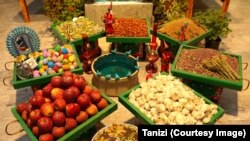There are no better treats for Norooz (Iranian New Year, March 21) celebrations than dry nuts and sweets for offering to visiting family and friends, but this year, prices for nuts have gone beyond the reach of most Iranians.
A kilo (2.2 pounds) of Grade A local pistachio goes for more than $15, based on free market exchange rates in Tehran. In local currency, a price of two million rials per kilo is just unimaginable.
Working class Iranians make between $100-200 a month and paying $15, or even $12 for pistachio is just out of question.
Local media report that prices have at least doubled since last Norooz and buyers are scarce. Merchants told The Islamic Republic News Agency (IRNA) that people stay away from the nuts market or buy very little. One merchant Mostafa Ahmadi told IRNA that prices for nuts have increased 100-200 percent.
Retail merchants and distributors offered several reasons for the price hike.
One explanation is drought, which has affected harvests. Another explanation is hording by producers who wait to fetch the best prices. But the main reason seems to be the devaluation of the local currency versus the dollar and euro.
The Iranian currency has fallen fourfold since the beginning of 2018, largely due to the withdrawal of the United States from the 2015 nuclear agreement and reimposition of tough economic sanctions.
Most prices in Iran have increased in par with the rise of the dollar. For imports Iran must pay in dollars and for domestically produced food, merchants can always export their products instead of selling them cheaper on the local market. In other words, Iranian nuts, famous for their quality in other countries, are fungible. They can be exported, earning foreign currency.
Prices of other food staples have also gone up. A kilo of red meat is about $10, or 1.2 million rials; when the minimum wage is around 12 million rials. So, if a factory worker buys a kilo of meat, he spends 10 percent of his monthly salary.
And it is not just minimum wage earners. A nuts retailer in Tehran told IRNA that even the middle classes have given up on buying the New Year treat. Although he said he still has his “special customers”, his sales volume is half of last year.







